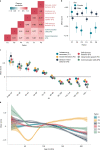Genetic correlates of phenotypic heterogeneity in autism
- PMID: 35654973
- PMCID: PMC9470531
- DOI: 10.1038/s41588-022-01072-5
Genetic correlates of phenotypic heterogeneity in autism
Abstract
The substantial phenotypic heterogeneity in autism limits our understanding of its genetic etiology. To address this gap, here we investigated genetic differences between autistic individuals (nmax = 12,893) based on core and associated features of autism, co-occurring developmental disabilities and sex. We conducted a comprehensive factor analysis of core autism features in autistic individuals and identified six factors. Common genetic variants were associated with the core factors, but de novo variants were not. We found that higher autism polygenic scores (PGS) were associated with lower likelihood of co-occurring developmental disabilities in autistic individuals. Furthermore, in autistic individuals without co-occurring intellectual disability (ID), autism PGS are overinherited by autistic females compared to males. Finally, we observed higher SNP heritability for autistic males and for autistic individuals without ID. Deeper phenotypic characterization will be critical in determining how the complex underlying genetics shape cognition, behavior and co-occurring conditions in autism.
© 2022. The Author(s).
Conflict of interest statement
M.E.H. is a cofounder of and consultant to and holds shares in Congenica Ltd., a genetics diagnostics company.
Figures







References
-
- American Psychiatric Association. Diagnostic and Statistical Manual of Mental Disorders 5th edn (American Psychiatric Association, 2013).
Publication types
MeSH terms
Grants and funding
LinkOut - more resources
Full Text Sources
Other Literature Sources
Medical
Miscellaneous

